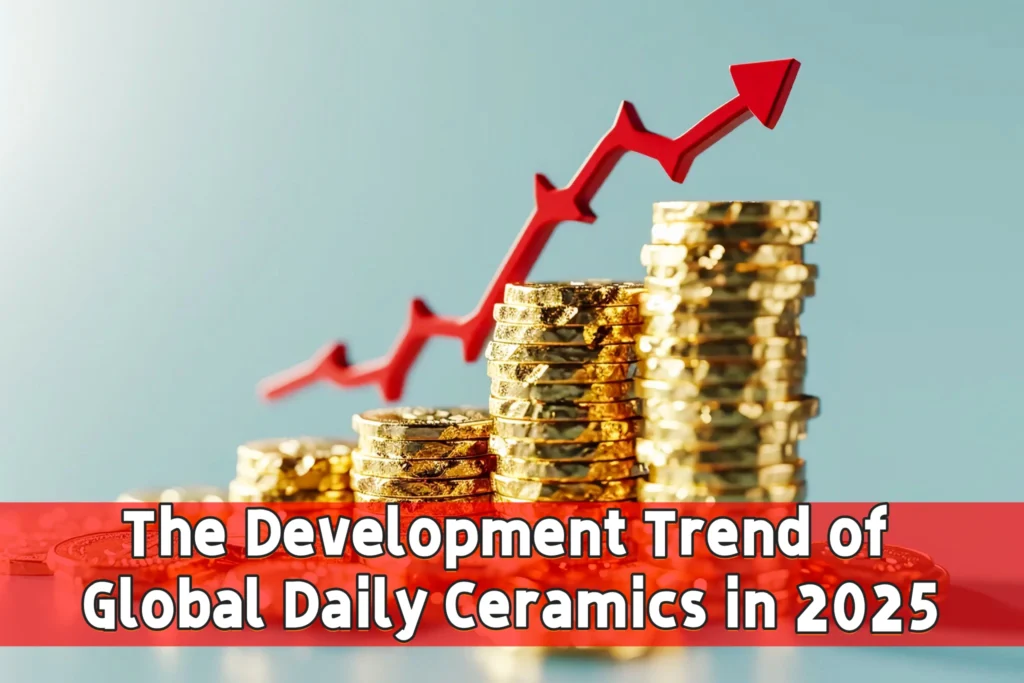Traditional Industries in Transition and New Opportunities
The global daily-use ceramic industry is undergoing a transformation from a “practical vessel” to a composite carrier of “technology+culture+environmental protection”. As a millennium old traditional industry, its market size is expected to exceed 120 billion US dollars by 2025, with a compound annual growth rate of 4.8%. However, regional differentiation and technological changes are reshaping the competitive landscape. This article will systematically analyze industry trends, segmented markets, and emerging opportunities.
1.Market panorama: coexistence of growth and differentiation
Scale and regional pattern
Asia Pacific leads production capacity, while Europe and America control high-end production: China contributes 65% of global ceramic production, with a domestic market size of over 50 billion yuan by 2025 and an annual growth rate of 8%. However, exports are mainly based on OEM, and domestic brands are scarce. Europe dominates the high-end market with its design advantages, with German brands such as Weibao and British brand Weichwood having a premium rate of over 30%, and Italian art ceramics having a unit price that can reach 10 times that of ordinary products.
Industrial cluster upgrading: China’s Chaozhou, Dehua and other bases promote intelligent transformation, with an automation rate of more than 75%, and cooperate with universities to form a technology alliance to extend to advanced ceramics and cultural innovation. Southeast Asia, relying on labor costs to undertake the transfer of mid to low end production capacity, saw Vietnam’s ceramic exports increase by 15% annually.
Consumer group fission
Parallel high-end and personalized: The global high-end tableware market is expected to reach 12.4 billion US dollars by 2025, with the Asia Pacific region leading the growth rate due to the expansion of the affluent class. The demand for customization has surged, such as the Jingdezhen “porcelain+” model supporting user participation in design, with an annual increase of 40% in order volume.
The rise of sustainable consumption: 67% of European and American consumers prioritize environmentally certified ceramics, and the European Union requires that the proportion of recycled materials exceed 20% by 2025, forcing companies to adopt bio based glazes.
2. Core Trends: Technology, Design, and Sustainability Reshaping the Industry
-Intelligent Manufacturing Revolution-
Automation and digital empowerment: Chaozhou ceramic enterprises have introduced AI flower surface design systems, which have increased development efficiency by 50%; 3D printing technology enables complex tool customization, with a yield rate increasing from 70% to 95%.
Intelligent ceramic productization: New products such as antibacterial glaze (silver ion technology) and self heating tableware (carbon fiber embedded) have emerged. The German Weibao intelligent insulation tray can maintain food temperature for 2 hours, and the commercial market growth rate has reached 11.2%.
Design driven value enhancement
Cultural IP empowerment: The Palace Museum branded products have a significant premium, such as the “Thousand Miles of Rivers and Mountains” tea set in the Forbidden City, which has a premium rate of 50%; Pop Mart Cross border Ceramic Blind Box, sold out on the first day of release.
Minimalist and functional fusion: KINTO from Japan focuses on “less but more refined” design, with a 30% reduction in weight while maintaining strength for its thin ceramic cups. Its market share in Europe and America has increased by 12% annually.
-Green supply chain transformation-
Material innovation: Bamboo fiber ceramics reduce sintering energy consumption by 40%, and biodegradable glaze research and development enterprises receive a surge in ESG investment.
Circular production mode: Dehua promotes “zero waste kilns”, with a waste porcelain recovery rate of 90%; The European brand promotion “trade in” program reduces raw material costs by 15% through the recycling of old porcelain.
3. Segmented Market: Structural Opportunities Emerge
Analyze from the perspectives of segmented categories, market characteristics, and innovation directions:
Tableware currently accounts for 40% of the overall market, with strong demand and innovative features such as antibacterial glaze, intelligent temperature control, and lightweight design.
Tea sets are increasing by 30% annually, driven by the revival of tea culture, and are starting to innovate intelligent brewing systems and cross-border joint IP.
The high-end market growth rate of home decoration ceramics is 18%, with a focus on 3D art sculpture and interactive intelligent decoration.
Tableware: Dual upgrade of functionality and aesthetics
Ceramic tableware is replacing metals and melamine in the high-end market, and the demand in the commercial sector is driven by the hotel industry. The commercial tableware service market is expected to reach 17.42 billion US dollars by 2032. Self repairing glaze (microcapsule technology) extends lifespan by three times, becoming a new standard for high-end hotel procurement.
Tea set: integration of traditional craftsmanship and modern technology
Intelligent tea sets integrate sensors to monitor water temperature and tea soup concentration in real time. Liling Enterprise has launched an “AI Tea Artisan” pot set, with a unit price exceeding 5000 yuan but still in short supply. Purple clay and porcelain are two worlds apart, and young people prefer the portable design of “Kuaike Cup”, resulting in a 35% increase in online sales.
Home Decoration Ceramics: Cross border of Art and Technology
The intelligent vase is equipped with a plant monitoring system, which prompts for water replenishment through an APP. The penetration rate in the European and American markets has increased by 25% annually. NFT digital art derived physical ceramic ornaments promote the integration of virtual and real consumption.
Want to learn more about China’s ceramic production areas:Daily-use porcelain production area
4.Regional market: Significant gradient development characteristics
Characteristics of Daily Ceramic Consumption in Major Global Regions
Region | Consumption Characteristics | Policy Environment | Growth Highlights |
North America | High-end customization, smart ceramics | Upgraded safety standards | Commercial demand accounts for 67%, reaching 6.7 billion US dollars |
Europe | Environmental certification, luxury brands dominate | Updated EU REACH regulations | German high-end ceramic exports increase by 12% |
Asia-Pacific | Significant differentiation: mass market in China + high-end in Japan and South Korea | China supports cultural and creative ceramics | E-commerce channel growth in Southeast Asia at 25% |
Middle East | Gilded ceramics, religious cultural elements | Low tariff barriers | Luxury demand grows by 18% annually |
The upgrading path of Chinese manufacturing: shifting from OEM to branding, Jingdezhen has launched the “Porcelain Capital Certification” system, and the enterprise’s own brand rate has increased from 35% to 71%.
High end barriers in Europe and America: Italian handmade painters earn over 300 euros per hour, and their craftsmanship is difficult to replicate.
5. Competitive landscape: hierarchical differentiation and breakthrough path
Top enterprises build ecological barriers
European luxury brand: German brand Weibao launches antibacterial glaze technology series, with commercial orders accounting for 60% of revenue; British Wedgwood co branded fashion designer, limited edition with a premium of 10 times.
Leading transformation in China: Huaci has developed the underglaze multicolour AI generation system, with more than 314 patents, and the proportion of overseas revenue has increased to 35%.
New forces' vertical breakthrough strategy
Cross disciplinary technology: Dehua Enterprise develops intelligent temperature controlled ceramic pots that are compatible with IH stoves.
Scenario innovation: Japanese brand launches stackable ceramic coffee cups, saving 50% space and becoming popular among urban singles.
6.Challenges and Future Opportunities
Core challenges
Cost and profit squeeze: Ceramic raw material prices have risen by 15% annually, forcing European companies to raise prices; The gross profit margin of Chinese OEM enterprises is less than 20%.
Technological dependence: High end glazes rely on imports from Japan and Germany, which increases the risk of supply interruption.
Breaking direction and opportunities
Material Revolution: Silicon nitride ceramic cutting tools with a hardness three times higher than metals, entering the high-end kitchenware market; Degradable clay reduces solid waste.
Global compliance: Establishing ESG certification system, carbon footprint label recognized by the European Union.
New scene fusion:
Metaverse+Ceramics: Virtual collectibles are bound to physical limited editions, with digital exhibition hall transactions exceeding tens of millions of dollars.
Instant customization: AI design tools support 24-hour customized delivery, with a repurchase rate of over 60%.

Conclusion: From "Practical Tool" to "Value Carrier"
The daily ceramic industry is transforming into a composite carrier that integrates intelligent manufacturing, cultural expression, and sustainable innovation. Enterprises need to focus on three major directions to break through:
High end technology (conquering intelligent glazes and low-carbon kilns)
Brand differentiation (deeply cultivating IP and cultural narrative)
Green supply chain (closed-loop production+recycled materials).
Only by breaking the shackles of ‘big but not strong’ can we occupy the high ground of the value chain in this billion level industrial upgrading.
As a daily-use ceramic enterprise rooted in Chaozhou, known as the “Porcelain Capital of China”, Myoung Ceramics has been deeply involved in the industry for 30 years. Relying on Chaozhou’s complete ceramic industry chain and millennium craftsmanship accumulation, we take intelligence, greenness, and cultural empowerment as the core to promote the upgrading of traditional ceramics from “practical tools” to a composite carrier of “technology+art+sustainability”.
Myoung Ceramics innovative practices and core competencies:
Introducing automated production lines to improve efficiency and quality, and reduce energy consumption.
Combining AI design, shortening the design cycle, and combining personalized customization.
Develop new ceramic products that combine environmental protection and functionality.
Create scenario based products, including tableware sets, baking trays, bathroom sets, candle aromatherapy jars, and other home products.rper mattis, pulvinar dapibus leo.
In the field of daily-use ceramics, the threshold for spot goods and customization has been lowered, providing one-stop customized and wholesale services.
We hope to have the opportunity to create a new future for ceramics with you.











